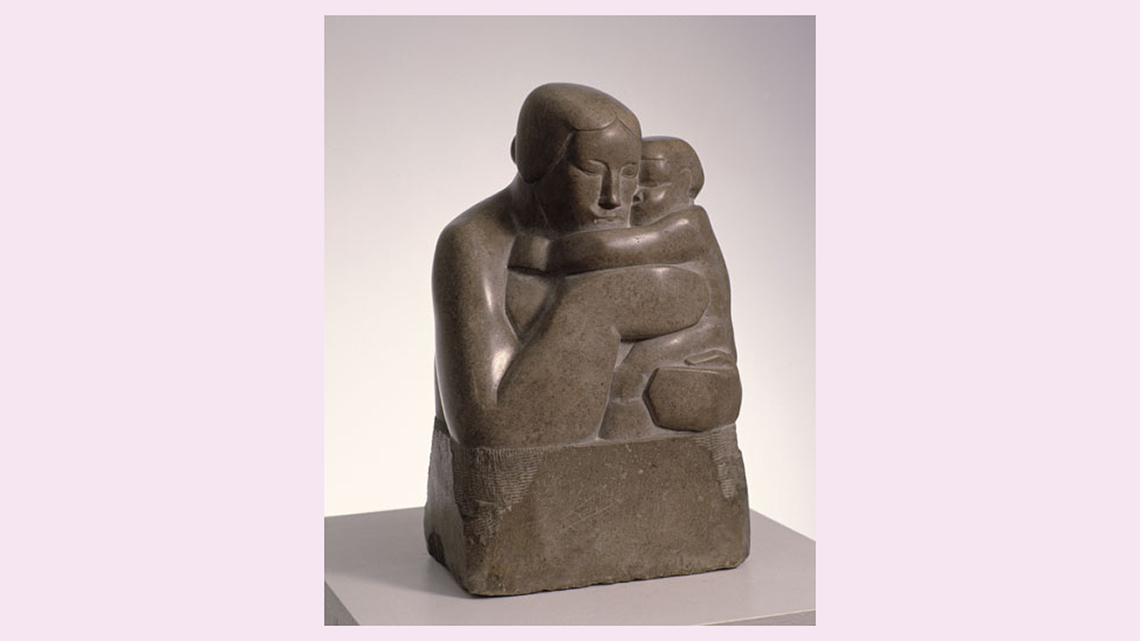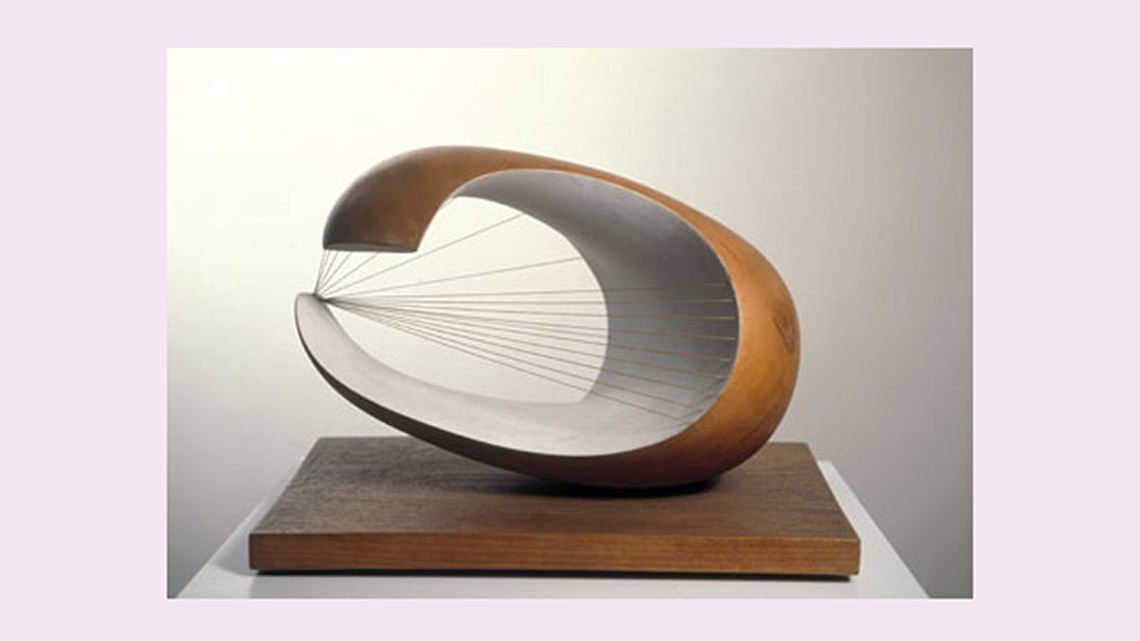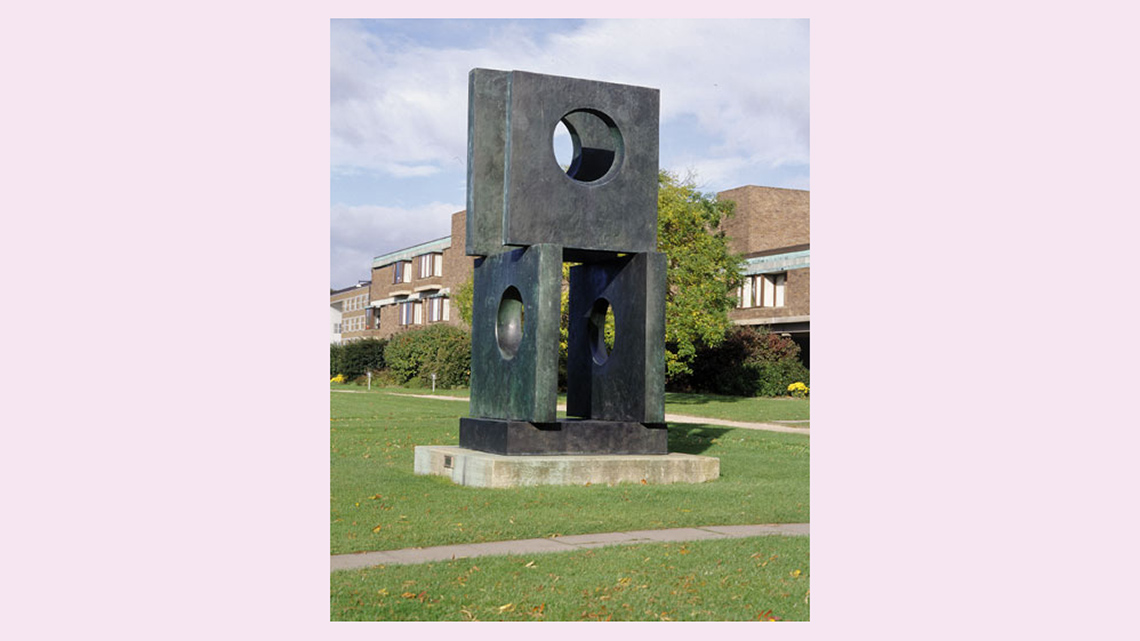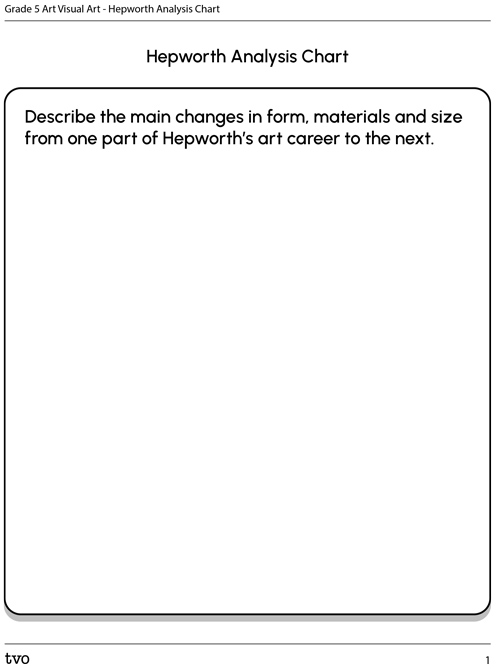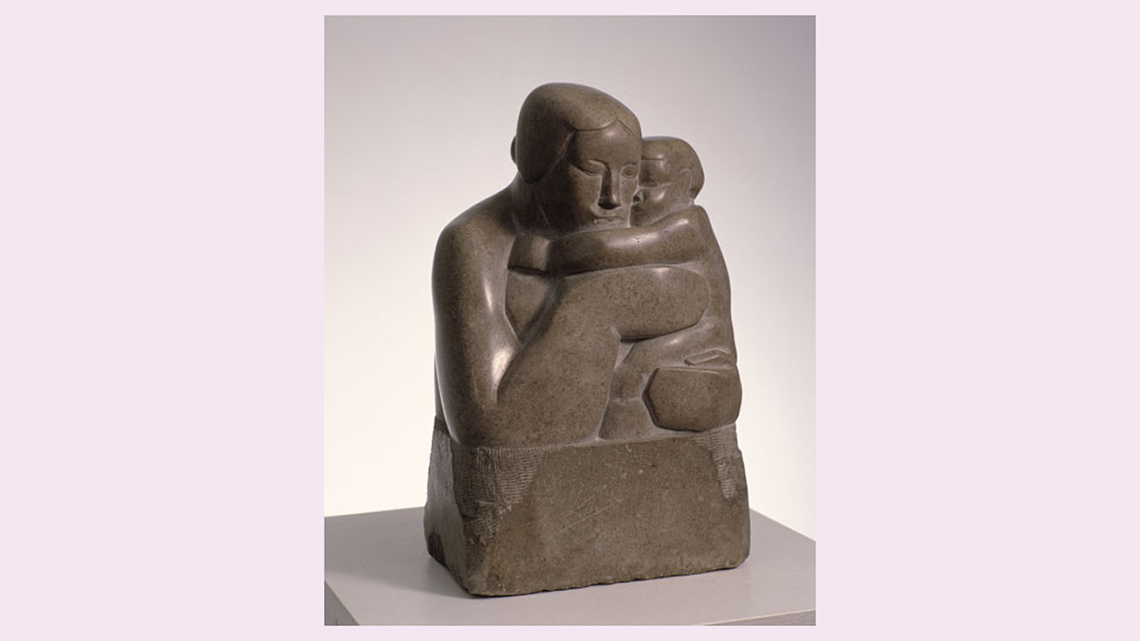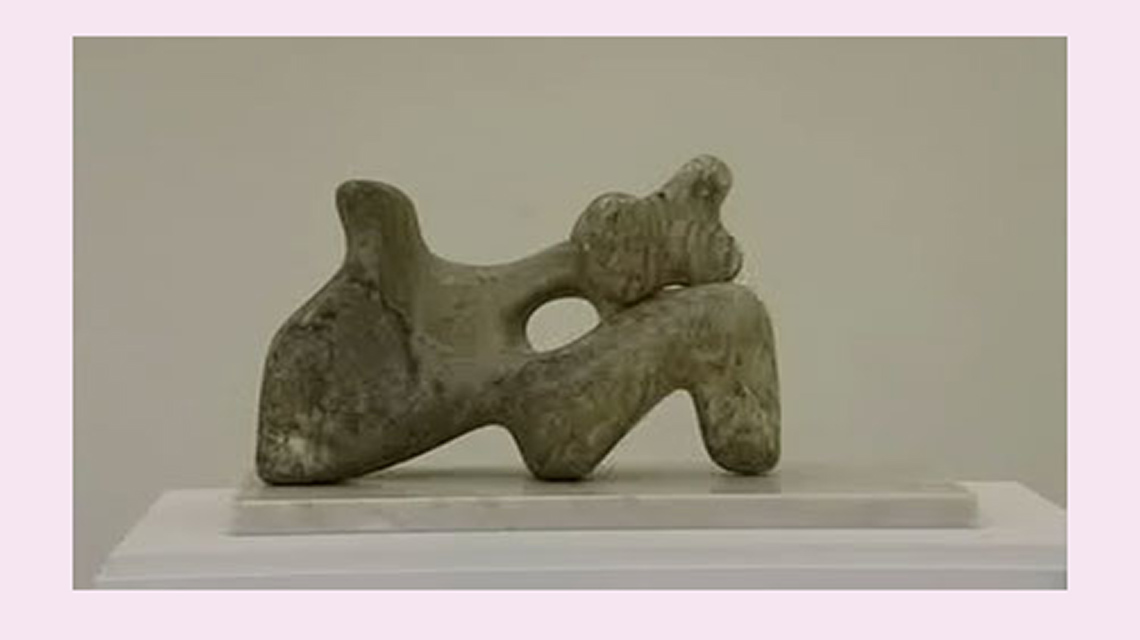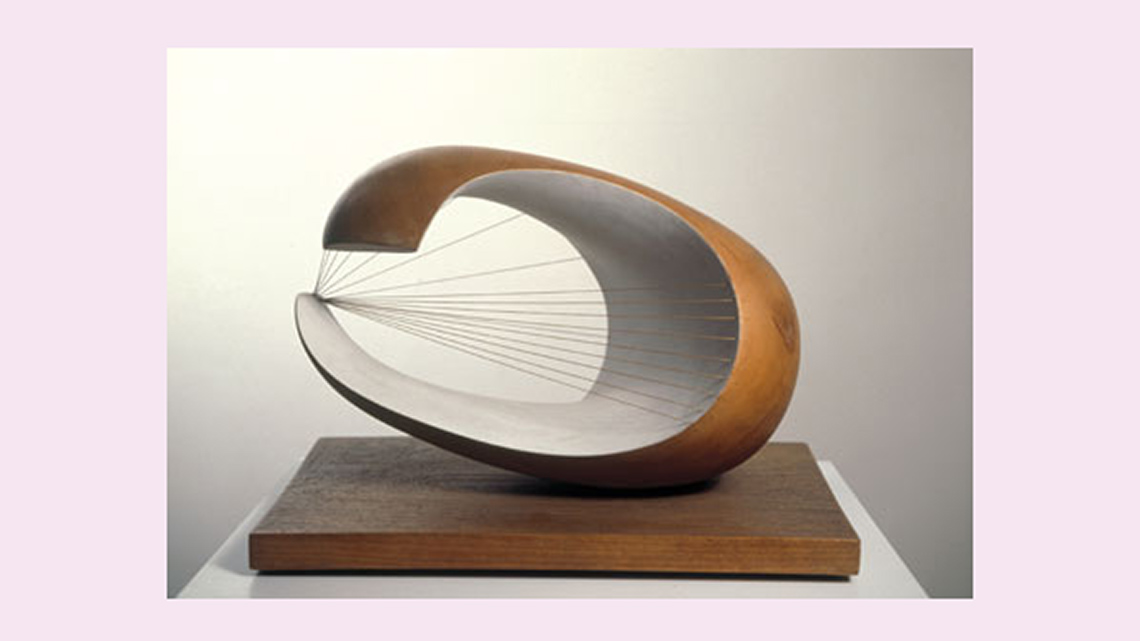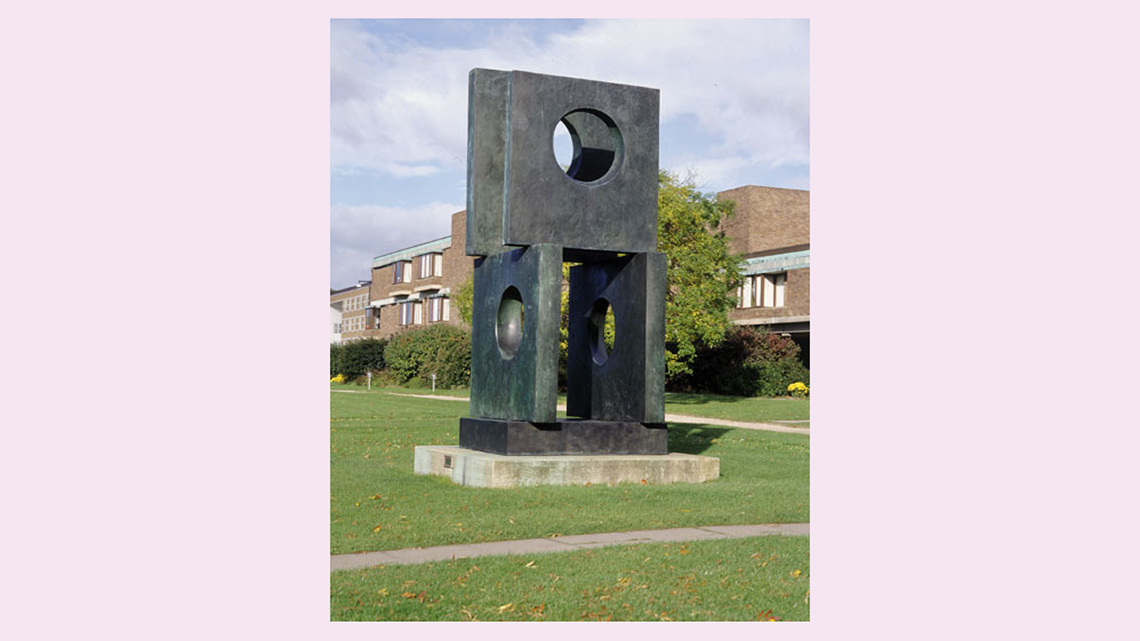Minds On
Let's get started!
Notice and wonder
Explore the following sculptures.
All of the following sculptures were created by the same artist.
What are some of the similarities and differences between the different sculptures?
What kinds of materials did the artist use to create their work?
Record your ideas on paper, digitally, or as an audio recording.
A carousel of four images. Image 1: Mother and Child 1927, Barbara Hepworth
This image is of sculpture which is carved out of a single block of stone. The carving is in the form of a large figure hugging a small figure. The small figure is hugging has their arms wrapped around the neck of the large figure. Both figures have their eyes closed. Details like the hairline, nose and mouth are defined in both figures.
Image 2: Mother and Child 1934, Barbara Hepworth
This image is of a sculpture that has been carved out of type of rock called alabaster. The sculpture is abstract. It is a curved, organic shape with an oval shape carved out through the middle and two triangular shapes carved out of the base.
Image 3: Wave, Barbara Hepworth
This image is of a sculpture made of medium brown wood. It resembles an oval shape that is sitting on its side with the inside portion scooped out. The remaining inside portion is coloured white. There are strings that have been attached to the outer edges of the sculpture to emphasize the empty part inside.
Image 4: Four-Square (Walk Through), Barbara Hepworth
The image is of a bronze sculpture which stands 4.3 metres (14 feet) high surrounded by grass. There are buildings along the side of the sculpture. It is made from 4 thick square-shaped bronze pieces. Two pieces are stacked parallel to each other on the bottom. The other two pieces on top are stacked perpendicular to the bottom pieces. Each piece includes a circular cut-out.
Action
Get ready, get set…
The sculptures of Barbara Hepworth
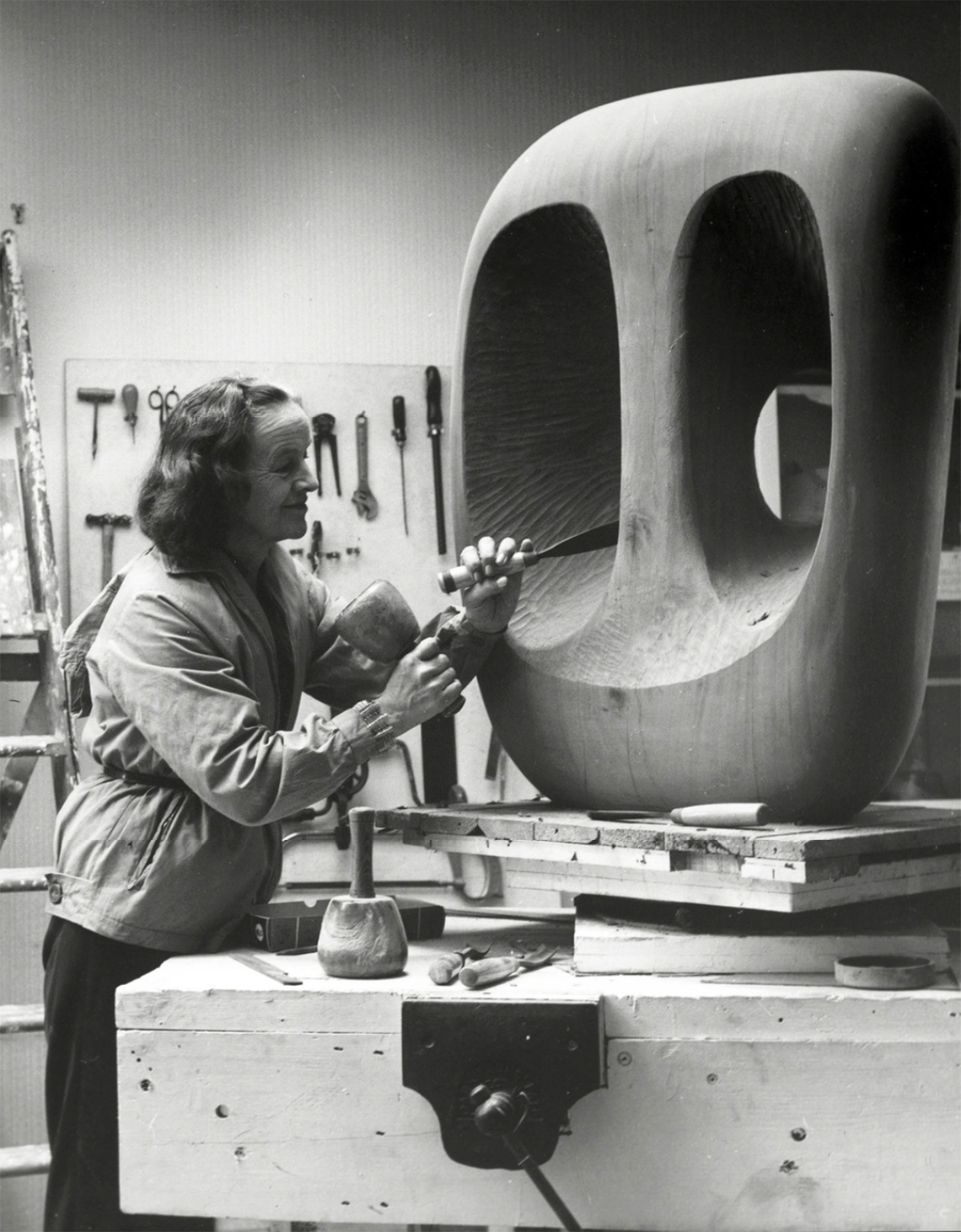
Barbara Hepworth in the Palais studio at work on the wood carving Hollow Form with White Interior
In the Minds On, we explored the work of Barbara Hepworth from the beginning of her career to the later part of her career. Hepworth was a British artist and sculptor. She created carved sculptures inspired by the natural world and has made over 600 sculptures in her lifetime!
Let’s go through Hepworth’s work to identify how her use of shape, materials, and form changed over time.
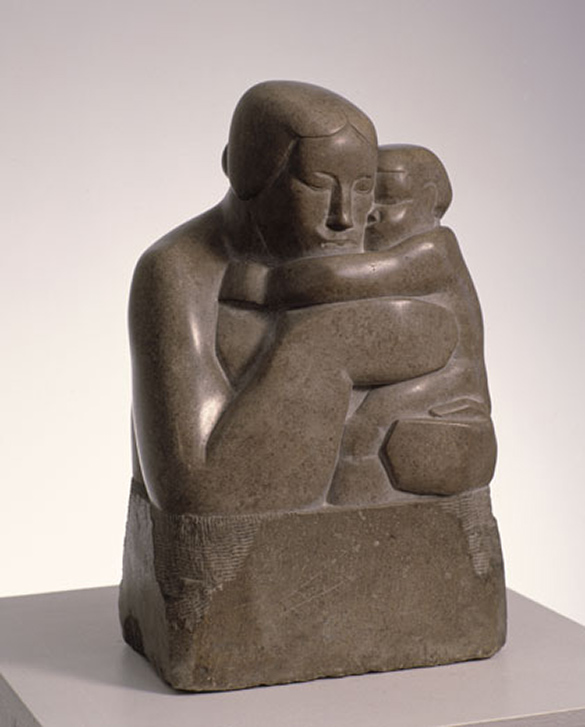
Mother and Child, by Barbara Hepworth, 1927
This image is of sculpture which is carved out of a single block of stone. The carving is in the form of a large figure hugging a small figure. The small figure is hugging has their arms wrapped around the neck of the large figure. Both figures have their eyes closed. Details like the hairline, nose and mouth are defined in both figures.
In 1927, Hepworth created her first Mother and Child sculpture. This piece was carved out of stone, and clearly shares the image of a mother holding their child.
Abstract forms
After this period, Hepworth graduated from the Royal College of Art in London and traveled to Florence, Italy to continue her studies. She learned marble carving from Italian master-carver Giovanni Ardini.
Hepworth described her time studying in Florence as the following: “He [Giovanni Ardini, Italian master-carver] opened up a new vista for me of the quality of form, light, and colour contained in the Mediterranean conception of carving.”
Compare the following sculpture also titled Mother and Child that Hepworth carved in 1934 after working with Giovanni Ardini.
How is the form similar or different from her earlier work, Mother and Child, 1927?

This image is of a sculpture that has been carved out of type of rock called alabaster. The sculpture is abstract. It is a curved, organic shape with an oval shape carved out through the middle and two triangular shapes carved out of the base.
Press ‘Possible Answer’ to learn how the form is similar or different than her previous work.
The form is more abstract in this sculpture. While the title lets the audience know what the sculpture is about, it’s less clear which part of the sculpture represents the mother and which represents the child. While it is still carved from stone, there are parts of the stone that Hepworth removed completely.
Negative space
As Barbara Hepworth continued her career, she began to integrate more negative space into her abstract sculptures.
Press ‘Definition’ to access the meaning of negative space.
Negative space is the empty space between an object or shape in an artwork. Negative space can become a negative shape when an artwork has boundaries. The opposite area is the positive space or positive shapes.
Hepworth did this by piercing her medium of wood or stone. Those holes and crevices became part of their sculpture. Hepworth said it was a way to show the insides of the sculpture as well as the outside. It also let light through heavy blocks of stone, wood, and metal.
Explore the following sculpture Wave created from 1943-1944.
How does this sculpture make use of negative space?
What does it remind you of?
What kind of materials do you notice in this piece?
Record your ideas using a method of your choice.
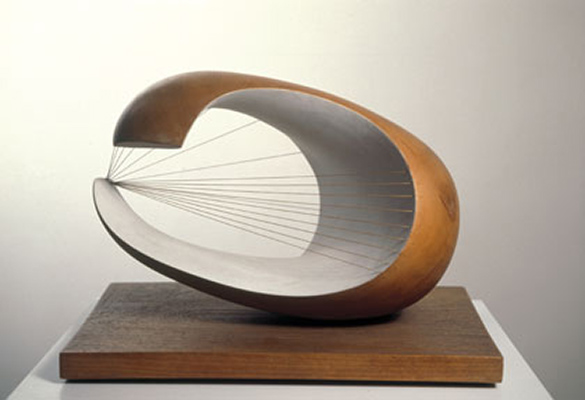
This image is of a sculpture made of medium brown wood. It resembles an oval shape that is sitting on its side with the inside portion scooped out. The remaining inside portion is coloured white. There are strings that have been attached to the outer edges of the sculpture to emphasize the empty part inside.
Press ‘Possible Answer’ to learn how Hepworth used negative space.
Hepworth scooped out the inside portion of the sculpture and has used string and colour to emphasize the negative space within. The contrast between the wood exterior and white interior creates interest and tension in the piece. It reminds me of a coconut, with both the outer shell and the inner part of the fruit. Hepworth used wood and string to create this piece. They combined organic form and natural materials.
Size
As Hepworth’s art career continued, her work continued to change.
Explore the following examples of Hepworth’s sculpture Four-Square (Walk Through) created in 1966.
What do you notice about the setting of the sculpture?
How is this sculpture similar and/or different from her earlier work Mother and Child, 1927?
How does Hepworth use negative space in Four-Square (Walk Through)?
Record your ideas using a method of your choice.
Press ‘Mother and Child’ to access the Mother and Child sculpture to do your comparison.
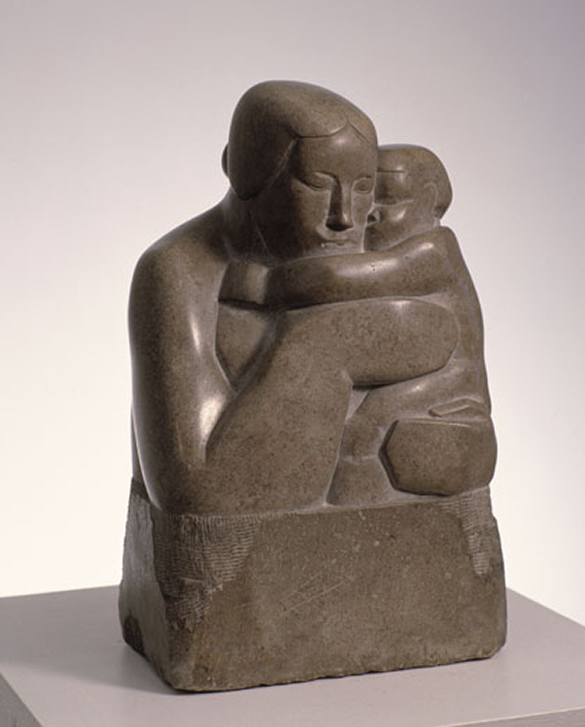
This image is of sculpture which is carved out of a single block of stone. The carving is in the form of a large figure hugging a small figure. The small figure is hugging has their arms wrapped around the neck of the large figure. Both figures have their eyes closed. Details like the hairline, nose and mouth are defined in both figures.
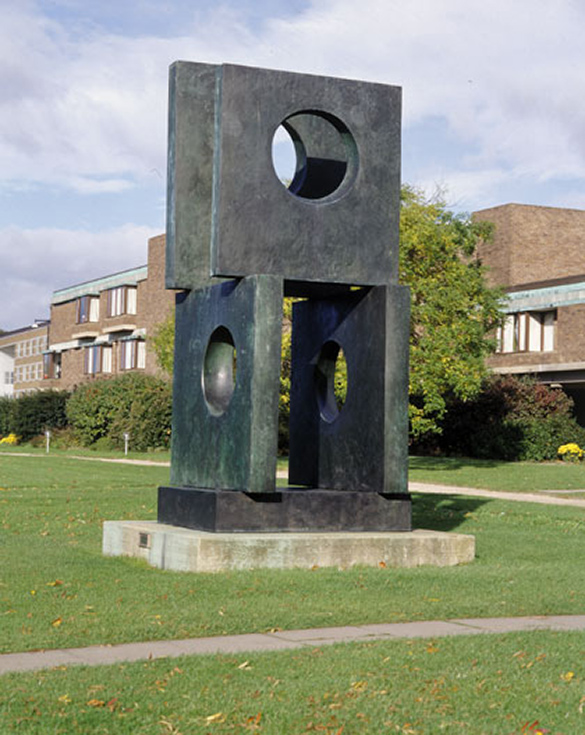
The image is of a bronze sculpture which stands 4.3 metres (14 feet) high surrounded by grass. There are buildings along the side of the sculpture. It is made from 4 thick square-shaped bronze pieces. Two pieces are stacked parallel to each other on the bottom. The other two pieces on top are stacked perpendicular to the bottom pieces. Each piece includes a circular cut-out.
Press ‘Possible Answer’ to access information about the Four-Square (Walk Through) piece.
Four-Square (Walk Through) is set in an outdoor space. It is a much larger sculpture than Mother and Child (1927). It is made of bronze instead of stone, and Hepworth has used geometric forms to create this work. She uses negative space by including circle cut-outs which allows light in through the sculpture.
Go!
Let’s return to all four examples of Barbara Hepworth’s sculptures. These represent different stages in her career. Explore each sculpture again and consider how Hepworth’s sculptures have changed over time.
Describe the main changes in form, materials, and size from one part of Hepworth’s art career to the next. Record your thoughts using the organizer below or using another method of your choice.
Complete the Hepworth Analysis Chart in your notebook or using the following fillable and printable document. If you would like, you can use speech-to-text or audio recording tools to record your thoughts.
Describe the main changes in form, materials and size from one part of Hepworth’s art career to the next.
A carousel of four images. Image 1: Mother and Child 1927, Barbara Hepworth
This image is of sculpture which is carved out of a single block of stone. The carving is in the form of a large figure hugging a small figure. The small figure is hugging has their arms wrapped around the neck of the large figure. Both figures have their eyes closed. Details like the hairline, nose and mouth are defined in both figures.
Image 2: Mother and Child 1934, Barbara Hepworth
This image is of a sculpture that has been carved out of type of rock called alabaster. The sculpture is abstract. It is a curved, organic shape with an oval shape carved out through the middle and two triangular shapes carved out of the base.
Image 3: Wave, Barbara Hepworth
This image is of a sculpture made of medium brown wood. It resembles an oval shape that is sitting on its side with the inside portion scooped out. The remaining inside portion is coloured white. There are strings that have been attached to the outer edges of the sculpture to emphasize the empty part inside.
The image is of a bronze sculpture which stands 4.3 metres (14 feet) high surrounded by grass. There are buildings along the side of the sculpture. It is made from 4 thick square-shaped bronze pieces. Two pieces are stacked parallel to each other on the bottom. The other two pieces on top are stacked perpendicular to the bottom pieces. Each piece includes a circular cut-out.
Consolidation
Putting it all together
You will be creating your own plan for a sculpture.
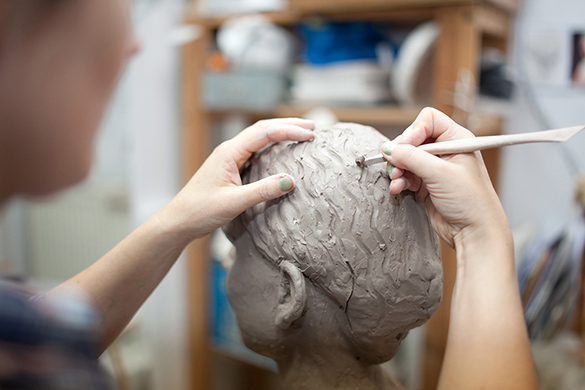
Materials Needed
Materials you might need
Possible materials you might need for this learning activity:
- pencil
- paper
- eraser
- medium options: air dry clay, play dough (bought or homemade), tin foil, found objects, foam, damp sand, or dirt
Student Success
Exploring digital creation options
When you are considering digital creation options, explore the variety of digital applications available!
Note to teachers: See your teacher guide for collaboration tools, ideas and suggestions.
Always be sure to do your safety checks before you do an activity.
Before you begin, check:
Safety
Before you begin, consider these safety precautions:
Now it’s your turn to create! Consider the following options to check out a variety of methods to create your art. Choose one option to try out.
Option 1: Description

Consider what you would like to represent in your sculpture. Use the following questions to create a detailed written/typed or audio description.
Will you be representing a person, place or thing?
Barbara Hepworth began their career by creating realistic forms through sculpture. Over time, their forms became more abstract.
Would you like to create using a realistic form or abstract form?
How might you incorporate negative space in your sculpture?
Hint: Barbara Hepworth carved pieces out of their medium to create negative space. If you choose to build your sculpture using found objects, you may choose to leave specific parts open in your sculpture. If you choose to create using any type of clay or playdough, consider how you might remove parts from your sculpture to create negative space.
Option 2: Digital

Create a digital drawing of your sculpture using a digital application of your choice.
Use the following questions to help guide your creation:
Will you be representing a person, place or thing?
Barbara Hepworth began their career by creating realistic forms through sculpture. Over time, their forms became more abstract.
Would you like to create using a realistic form or abstract form?
How might you incorporate negative space in your sculpture?
Option 3: Materials

Create a sculpture.
Possible materials:
- pencil
- paper
- eraser
- medium options: air dry clay, play dough (bought or homemade), tin foil, found objects, foam, damp sand, or dirt
Step 1: Create your sketch
Create a sketch of your form on paper or digitally. You will use this sketch to create a sculpture. Use the following questions to guide your sketch.
- Will you be representing a person, place or thing?
Barbara Hepworth began their career by creating realistic forms through sculpture. Over time, their forms became more abstract.
- Would you like to create using a realistic form or abstract form?
- How might you incorporate negative space in your sculpture?
Step 2: Decide on size
Consider the scale or size of your sculpture. Will you create something that is small or large? Once you have decided on the scale of your sculpture, use your sketch to begin sculpting, if possible.
Step 3: Integrating negative space
If you choose to build your sculpture using found objects, you may choose to leave specific parts open in your sculpture. If you choose to create using any type of clay or playdough, consider how you might remove parts from your sculpture to create negative space.
Steps for air dry clay

- Roll the clay on a dry surface and create a ball that can be molded into the shape you have created in your drawing.
- Using pinching, pulling, and/or piercing create your form or forms.
- Let the clay dry overnight.
Note: If you are creating your sculpture using found objects, take a photo from several angles to have a record, if possible. You may also keep your sketches or description and add them to your art portfolio.
Portfolio
Track your progress
Reflect on your learning in this activity.
What do you think about your final product?
What do you enjoy about your sculpture?
What is something you did well?
Is there a part you would do differently if you try it again?
If possible, share your art with a peer.
Explain your process. Use vocabulary words like negative space and explain the person, place or thing you were trying to represent. You may record your process using any method of your choice.
If you have a portfolio, you can put your art there to track your progress over time.
Reflection
As you read through these descriptions, which sentence best describes how you are feeling about your understanding of this learning activity? Press the button that is beside this sentence.
I feel…
Now, record your ideas using a voice recorder, speech-to-text, or writing tool.
